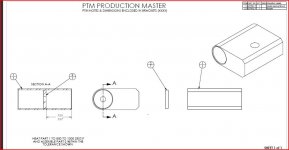Wingshot
Plastic
- Joined
- Mar 25, 2012
- Location
- Pequot Lakes, Minnesota
I would like to get some feed back on using liquid nitrogen for shrink fitting parts. I want to know what is the actual physical change in properties to the steel are when using liquid nitrogen. Are there any change in strength or any other effects after warming to its natural state? The material I'm using is 440C and it doesn't get hardened after. I have .0006 to .0007 press fit. The part I want to cool is a washer .187 thick X .600 diameter with a .12 hole in the center.
If I use a coefficient of linear expansion of 5.7. I might be able to use Dry ice with Acetone bath. However, it that don't work I would like to have the option of using liquid nitrogen, but I don't know what the physical change in properties might be.
I would appreciate any input
Thanks'
If I use a coefficient of linear expansion of 5.7. I might be able to use Dry ice with Acetone bath. However, it that don't work I would like to have the option of using liquid nitrogen, but I don't know what the physical change in properties might be.
I would appreciate any input
Thanks'





